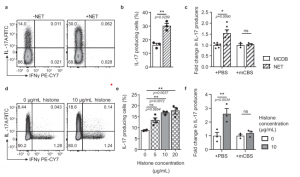In a recent study, Wilson, et al., have described how Th17 cell promote the onset of certain autoimmune diseases such as multiple sclerosis (MS). The researchers have discovered a mechanism used by Th17 to fulfil its function within the immune system – neutrophil extracellular traps (NETs). These NETs play a role in elevating the expression of inflammatory Th17 cells (Read more: Neutrophilic aid – extracellular traps to enhance macrophage directed bacterial killing). They are hoping that this discovery may lead to new ways to inhibit or disrupt these inflammatory NET-Th17 interactions in order to reduce harmful inflammation. Consequently, this may lead to better treatments of diseases such as MS (sign-in and read more: NETs – a new strategy for using old weapons).
Th17 cells, which are normal beneficial to the immune system, have a bad side when activated past their necessity as they can cause harmful inflammation, promoting harmful conditions within the body. NETs, produced by neutrophils, function to trap and destroy pathogenic bacteria and protect the body from infection. However, Wilson, et al., found that these NETs activate Th17 cells thereby enhancing their detrimental effect (Figure 1).

Figure 1: 1 Neutrophil extracellular traps (NETs) promote Th17 cell differentiation through histones.a, b IL-17 and IFNγ expression by in vitro differentiated Th17 cells measured by flow cytometry after culture in the presence or absence of in vitro generated NETs n = 3. c Normalized IL-17 production by Th17 cells differentiated in the presence of NETs in MCDB media or MCDB media alone with the addition of histone inhibitor mCBS. d, e IL-17 and IFNγ expression by in vitro differentiated Th17 cells cultured with a low concentration of histones (0–20 µg/mL) n = 3. f Normalized IL-17 production of Th17 cells differentiated with histones with the addition of histone inhibitor mCBS n = 3. Data bars show mean ± SEM. “ns” (not significant), p > 0.05; “*”p < 0.05; “**”p < 0.01. b Paired two-tailed t-test, c, f two-way ANOVA with Sidak’s multiple comparisons test, e one-way ANOVA with Tukey’s multiple comparisons test. Data points represent individual mice. All data are representative of a minimum of two independent experiments. Source data are provided as a Source Data file (Wilson, et al., 2022).
Seeing that histones in humans and mice, proteins within NETS, can activate Th17 cells leading to them becoming harmful, the team thought to target these histones with a histone-neutralizing drug, mCBS. This drug was originally developed to treat sepsis. In the long term, though one cannot prevent autoimmune diseases such as MS, therapies such as these may lead to a potential treatment which will allow for the management of such diseases.
Journal article: Wilson, A. S., et al., 2022. Neutrophil extracellular traps and their histones promote Th17 cell differentiation directly via TLR2. Nature Communications.
Summary by Stefan Botha










